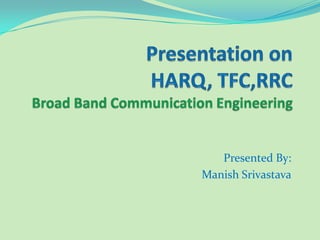
Harq
- 2. Hybrid automatic repeat request (HARQ) HARQ is a combination of high-rate forward error- correcting coding and ARQ error-control. The FEC code is chosen to correct an expected subset of all errors that may occur. ARQ method is used as a fall-back to correct errors that are uncorrectable using only the redundancy sent in the initial transmission. HARQ can be used in stop-and-wait mode or in selective repeat mode
- 3. TYPES of HARQ Simple Hybrid ARQ Type I HARQ Type II HARQ o Hybrid ARQ with soft combining Chase combining Incremental redundancy
- 4. Type I HARQ and Type II HARQ Type I HARQ, adds both ED and FEC information to each message prior to transmission. Type II HARQ, the message originator alternates between message bits along with error detecting parity bits and only FEC parity bits.
- 5. HARQ with soft combining In practice, incorrectly received coded data blocks are often stored at the receiver rather than discarded, and when the retransmitted block is received, the two blocks are combined. This is called Hybrid ARQ with soft combining.
- 6. Chase combining Chase combining: every retransmission contains the same information (data and parity bits). One could think of every retransmission as adding extra energy to the received transmission through an increased Eb/N0
- 7. Incremental redundancy Incremental redundancy: every retransmission contains different information than the previous one. Thus, at every retransmission the receiver gains extra information.
- 8. PRACTICAL IMPLEMENTATION An example of incremental redundancy HARQ is HSDPA: the data block is first coded with a punctured 1/3 Turbo code, then during each (re)transmission the coded block is usually punctured further (i.e. only a fraction of the coded bits are chosen) and sent. The puncturing pattern used during each (re)transmission is different, so different coded bits are sent at each time. Although the HSDPA standard supports both chase combining and incremental redundancy, it has been shown that incremental redundancy almost always performs better than chase combining, at the cost of increased complexity.
- 9. APPLICATION AREAS HARQ is used in HSDPA and HSUPA which provide high speed data transmission. for mobile phone networks such as UMTS. IEEE 802.16-2005 standard. 3GPP Long Term Evolution (LTE).
- 10. Wideband CDMA Air Interface: Protocol Stack TFC Selection: Index Terms: TF, TTI and TFC RRC: RRC Services and Functions AND Protocol States.
- 11. TF, TTI and TFC 1. Transport format (TF) defines what kind of data and how much is sent on each transport channel in each transport time interval (TTI). 2. Transport format combination (TFC) is a set of TFs. Indirectly, TFC gives the data rate used.
- 12. Process of TFC selection: 1. The MAC layer has to choose a set of TFs, so that given the current channel conditions, the maximum amount of highest-priority data could be transmitted over the air interface. ** Remarks: This is not a simple task. 2. The MAC layer itself knows from the configuration data which transport formats and which combinations of transport formats are valid. ** Remarks: The current channel conditions could impose limitations on what TFCs can be used.
- 13. Important Considerations 1. Those combinations that could carry the highest amount of data also need the highest transmit power in the physical layer. ** Remarks: In a CDMA system, more data basically means more power. 2. The more noise there is in the radio interface, the higher the transmitting power must be. ** Remark: In a noisy environment, only some of the TFCs can be used
- 14. 3.The data to be transmitted is in the data buffers in the RLC layer. 4.The MAC layer is not allowed to choose TFCs that require the RLC layer to add padding bits to its PDUs to make them match with the chosen TFC (i.e., to choose too large TFCs).
- 15. NOTE: 1.TF selection must be done on all DCHs, and also on RACH and CPCH channels. 2. The TFC selection algorithm is not, and will not be, specified by the 3GPP.
- 16. The conductor of the protocol stack orchestra RRC 1. General control. This is an information broadcast service. 2. Dedicated control. This service includes the establishment and release of a connection and the transfer of messages using this connection. 3. Notification. This includes paging and notification broadcast services.
- 17. RRC functions 1. Initial cell selection and cell reselection. 2. Broadcast of information. 3. Reception of paging messages. 4.Establishment, maintenance, and release of RRC connection. 6. Handovers (HOs). 7. Control of requested QoS. 8.Contention resolution AND Timing advance in the TDD mode.
- 18. THANKS ALL !!
